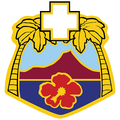| Tripler Army Medical Center | |
|---|---|
| Defense Health Agency | |
 | |
 Main hospital building | |
 | |
| Geography | |
| Location | 1 Jarrett White Road, Honolulu, Hawaii, U.S. |
| Coordinates | 21°21′43″N157°53′22″W / 21.36194°N 157.88944°W |
| Organisation | |
| Care system | Tricare |
| Funding | Government hospital |
| Type | Military hospital |
| Services | |
| Emergency department | Level II Trauma Center [1] |
| Beds | 231 [2] |
| Helipad | Yes |
| History | |
| Construction started | 1948 (current building) |
| Opened | 1907 |
| Links | |
| Website | www |
| Lists | Hospitals in U.S. |
Tripler Army Medical Center (TAMC) is a major United States Department of Defense medical facility administered by the United States Army in the state of Hawaii. It is the tertiary care hospital in the Pacific Rim, serving local active and retired military personnel along with residents of nine U.S. jurisdictions and forces deployed in more than 40 other countries in the region. [3] Located on the slopes of Moanalua Ridge [4] overlooking the Honolulu neighborhoods of Moanalua and Salt Lake, Tripler Army Medical Center's massive coral pink structure can be seen from any point in the Honolulu District. It also serves as headquarters of the Regional Health Command - Pacific. [5] The main hospital facility is within the Honolulu census-designated place. [6]

